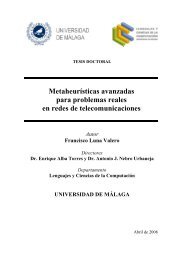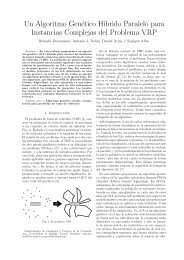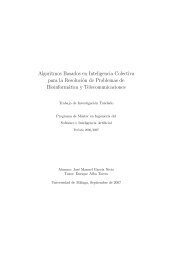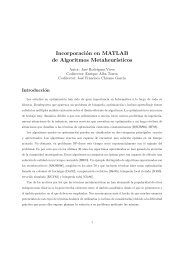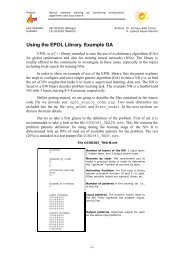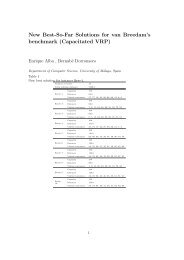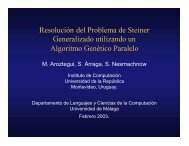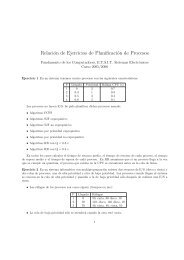Comparing Synchronous and Asynchronous Cellular Genetic ... - NEO
Comparing Synchronous and Asynchronous Cellular Genetic ... - NEO
Comparing Synchronous and Asynchronous Cellular Genetic ... - NEO
Create successful ePaper yourself
Turn your PDF publications into a flip-book with our unique Google optimized e-Paper software.
We have seen that, contrary to the behavior of cellular automata (CA’s), the<br />
simple Line Sweep policy performs better than the rest in cEA’s. Such a result<br />
can be explained by the fact that, in cEA’s, we don’t have a propagation of signals<br />
like in CA’s, having instead a propagation of information on the solution of the<br />
problem. It is true that Line Sweep fixes a preferred direction of propagation in<br />
the axes of the grid, but such an order speeds the propagation of information<br />
in the population. In fact, if we take our 50 × 50 toroidal population grids with<br />
the chosen von Neumann neighborhood, in synchronous cEA’s the information<br />
of an individual will take at least 50 time steps (i.e. 125000 evaluations) to<br />
reach the farthest individual in the grid, while in a cEA with asynchronous Line<br />
Sweep update method, it can take a small value such as 1 time step (i.e. 2500<br />
evaluations).<br />
6 Conclusions<br />
In this paper we have analyzed the behavior of three alternative policies for<br />
asynchronously updating the population of a decentralized cellular GA. We have<br />
initiated this research line because we had some preliminary expectations relating<br />
asynchronous policies in the field of cellular automata [14] <strong>and</strong> distributed GA’s<br />
[2]. We have tackled this study by considering three representative problems:<br />
deceptive (MMDP), epistatic (P-PEAKS) <strong>and</strong> hard (FMS) problems. Our first<br />
conclusion is that, for any size of the search grid, the synchronous update policy<br />
is the best in terms of percentage of hits, because it always provides an equal or<br />
larger success rate with respect to any of the asynchronous policies.<br />
However, if we consider the number of evaluations needed to locate the optimum<br />
(efficiency) we got the opposite conclusion: asynchronous methods are<br />
faster (sometimes much faster) than the synchronous one. A simple asynchronous<br />
policy such that Line Sweep (LS) provides the faster convergence for two of the<br />
problems (MMDP <strong>and</strong> P-PEAKS), while it shows a high <strong>and</strong> desirable success<br />
rate (similar to that of the synchronous update). In the hard FMS problem,<br />
Fixed R<strong>and</strong>om Sweep got a considerably faster solution, <strong>and</strong> can be pointed out<br />
as a good approach.<br />
Globally stated, fast convergence means local optima in evolutionary algorithms,<br />
but cellular GA’s in general, <strong>and</strong> the Line Sweep policy in particular,<br />
offers a good tradeoff solution to this problem without bothering researchers<br />
with a large number of parameters to be tuned (maybe only the ratio between<br />
the size of the grid <strong>and</strong> the neighborhood being used [1]).<br />
As a future work, we will enlarge the set of considered problems, include a<br />
study of the influence of the shape of the 2-d grid containing the population,<br />
<strong>and</strong> try to better characterize the relationship between the performance measures<br />
<strong>and</strong> the kind of problems.<br />
References<br />
1. E. Alba <strong>and</strong> J. M. Troya. <strong>Cellular</strong> evolutionary algorithms: Evaluating the influence<br />
of ratio. In M. Schoenauer et al., editor, Parallel Problem Solving from






